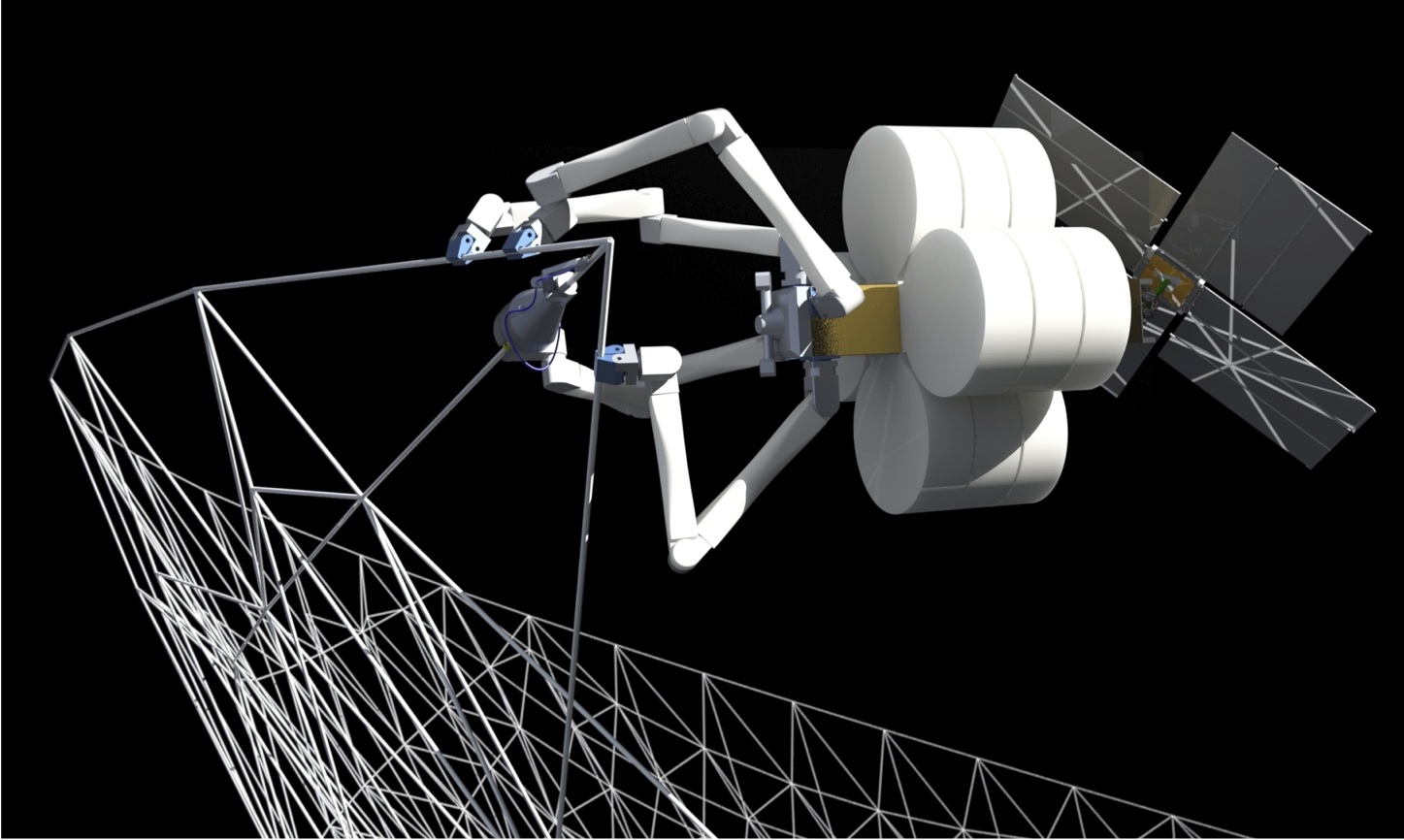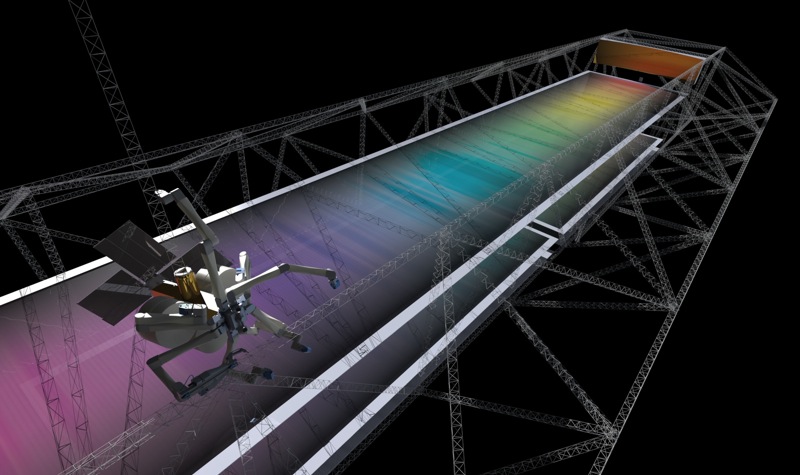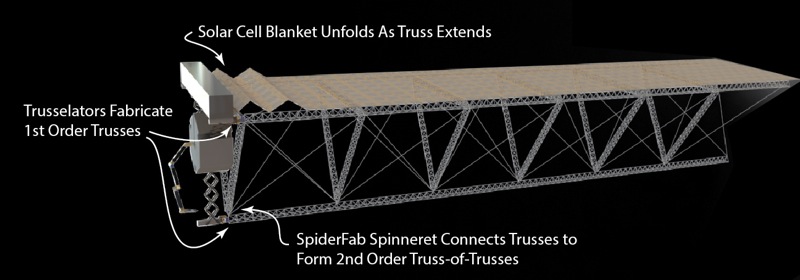Incredible Technology: Spiderlike Robots Could Build Giant Space Structures


Humanity could soon be building huge structures in space one piece at a time, the way spiders spin their webs here on Earth.
A company called Tethers Unlimited is developing an in-space manufacturing system called "SpiderFab," which would use arachnidlike robots to put together large objects in orbit or beyond.
SpiderFab could help build big radio antennas, spacecraft booms and solar arrays in the next decade or so, said Rob Hoyt, CEO and chief scientist of Tethers Unlimited. But he has an even grander vision for the technology (and associated projects the company is working on) over the long haul. [Visions of the Future of Human Spaceflight]
"Our really long-term objective for all of this work is to eventually enable the use of in-situ resources to construct the infrastructure in space needed to support humanity's expansion throughout the solar system," Hoyt said March 4 during a presentation with NASA's Future In-Space Operations (FISO) working group.
Bringing costs down
Hoyt believes that the current model of spacecraft manufacturing — in which everything is built and assembled on the ground, and is then launched in one piece — leaves plenty of room for improvement.
"It's a very expensive and time-consuming process, and also, the size of systems is somewhat limited by the size of the deployables that are possible to fold up and fit within a launch shroud," he said.
SpiderFab is an effort to decrease costs and increase efficiencies. The idea calls for launching raw materials, such as carbon fiber, to orbit. There, robots would transform these materials into truss substructures, and then assemble and integrate these pieces into larger systems.
Breaking space news, the latest updates on rocket launches, skywatching events and more!
The potential benefits of such an approach are substantial, Hoyt said.
"The primary one will be that we can deploy apertures and baselines that are much larger than we can currently fit into launch shrouds," he said. "The payoff of that will be higher power, higher resolution, higher sensitivity and higher bandwidth for a wide range of NASA, DoD [Department of Defense] and commercial space missions."
Furthermore, objects built in space can be sleeker and simpler than ones launched from the ground, since they don't need to survive the rigors of launch. That should lead to reductions in design complexity and system mass, which could lead to significant cost savings, Hoyt added.
Case studies
SpiderFab has received two rounds of funding from the NASA Innovative Advanced Concepts (NIAC) program, which aims to encourage the development of potentially game-changing space technologies.
According to Hoyt, case-study analyses conducted under the Phase 1 NIAC award indicated that SpiderFab could achieve order-of-magnitude performance improvements in systems in which "bigger is better" — components such as solar arrays and telescope parts. [Incredible Technology: Space Travel and Exploration]
As an example of SpiderFab's potential, Hoyt cited the proposed New Worlds Observer (NWO) space telescope, which would use a huge "starshade" to block out most of the light of a target star, thus allowing its orbiting exoplanets to be imaged directly.
The largest conventionally built starshade would be about 203 feet (62 meters) wide, Hoyt said. Employing on-orbit manufacturing with the same amount of mass would increase that diameter to 406 feet (124 m), allowing NWO to peer twice as close to target stars — and thus observe more planets, Hoyt added.
In addition, launching the starshade in raw-material form, rather than in finished form, reduces its volume by a factor of 30, thus allowing a smaller (and therefore cheaper) rocket to be used for the potential mission, Hoyt said.
"All those benefits combine to enable NASA to basically buy 16 times more habitable planets per taxpayer dollar," he said.
How it would work
At the heart of the SpiderFab concept is a multiarmed robot that would fabricate structural elements with one "spinneret" and use another one to join these pieces together as it crawls about on the ever-growing "web."
Tethers Unlimited, which is based in Bothell, Washington, is working to develop the various technologies required to pull off such an ambitious vision, Hoyt said.
For example, in a project funded by NASA's Small Business Innovation Research (SBIR) program, the company already built a machine that creates lightweight structural trusses from raw carbon-fiber spools, using a process akin to 3D printing.
This "trusselator," which is about the size of a microwave oven, can churn out truss — the type of stuff that could be put together to form a spacecraft boom and other systems — at the rate of 2 inches (5 centimeters) per minute, Hoyt said.
"Under the NIAC and SBIR work, I think we've already validated the basic feasibility of the key processes required" for the broad SpiderFab concept, he said.
The team is currently working on a second-generation trusselator, and hopes to have a prototype ready by early summer. Tethers Unlimited wants to launch a small "MakerSat" a couple of years from now to demonstrate the process on orbit. This spacecraft may end up being a CubeSat deployed from the International Space Station, Hoyt said.
The company has also bought a commercially available Baxter robot, and is using the machine to learn how to assemble trusses robotically. Hoyt and his colleagues will continue to develop and refine this process on the ground, and then aim to launch a "MakerSat 2" to prove it out in space — perhaps by building the truss structure for a big starshade.
"In a perfect world — if funding flowed and the contracting process didn't drag on forever — we think we could get to be able to build very large support structures for antennas and solar arrays, and those sorts of components, in the early 2020s," Hoyt said.
Follow Mike Wall on Twitter @michaeldwall and Google+. Follow us @Spacedotcom, Facebook or Google+. Originally published on Space.com.

Michael Wall is a Senior Space Writer with Space.com and joined the team in 2010. He primarily covers exoplanets, spaceflight and military space, but has been known to dabble in the space art beat. His book about the search for alien life, "Out There," was published on Nov. 13, 2018. Before becoming a science writer, Michael worked as a herpetologist and wildlife biologist. He has a Ph.D. in evolutionary biology from the University of Sydney, Australia, a bachelor's degree from the University of Arizona, and a graduate certificate in science writing from the University of California, Santa Cruz. To find out what his latest project is, you can follow Michael on Twitter.


